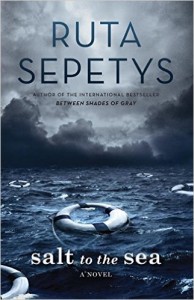 I love historical fiction. Strangely, the reason I seem to love it most is that I find it humbling in two ways.
I love historical fiction. Strangely, the reason I seem to love it most is that I find it humbling in two ways.
First, the characters of historical fiction are almost always experiencing horrendous events or struggling against impossible odds that I have never had to face. Second, though I consider myself to be reasonably well versed in U.S. and world history, historical fiction routinely smacks me in the face with some historical event, time period, or consequence that I somehow completely missed. How, before I read Orphan Train, did I never know about the organized movement of thousands of young children into middle America during the Great Depression?
And how was I naively unaware of the largest maritime disaster in history before I read Ruta Sepetys’ new novel, Salt to the Sea?
The Plot
This brand-new piece of historical fiction follows four narrators during World War II: three teenage Prussian (now the area containing countries like Latvia and Lithuania) refugees and one young German sailor. Each carries a troubling secret that he or she has never told anyone. The three refugees meet on the road, each coming from a very different background and set of circumstances. They are all headed for the Baltic Sea, hoping to escape an encroaching Russian army by boarding a German ship headed toward relative safety. Unfortunately, it seems that safety does not always come as advertised.
Why It’s Worth Reading
There is so much to this book and its characters that make it fascinating and exciting. But it is also a well-researched fictional account of what may have occurred leading up to and during the worst maritime disaster in history. We’re talking about nearly six times as many deaths as the Titanic, and yet I had never before heard of the Wilhelm Gustloff or its epic demise.
I initially picked up this book because I am a huge fan of the author, Michigan native Ruta Sepetys, and her works Between Shades of Grey and Out of the Easy. This book did not disappoint. I was immediately captured by the fascinating and mysterious cast of characters: a talented art restorationist mixed up in the Nazi art-thievery plot; a nurse-in-training who is compelled to step in as local doctor wherever she goes; a naive and self-important German boy, bound and determined to serve the Reich in any way that will garner praise. How can one not be drawn in by these varied tales that come together so seamlessly?
The fast, short chapters, which each character tells in succession, added a sense of suspense and action that really kept me turning pages as well. I regularly hear from history teachers that they are always on the lookout for World War II novels that aren’t necessarily focused on the Holocaust, and this one is sure to be a hit, particularly because of its high-interest content but relatively low reading level. It’s a great classroom-connection novel and a fantastic find for historical fiction lovers everywhere!
Book Details
Reading Levels: AR = unknown , Lexile = HL560L
ISBN: 9780399160301
Format: Hardcover
Publisher: Philomel Books
Publication Date: February 2, 2016
Awards: None yet, but I wouldn’t be surprised if it received some eventually. It’s only been out for 3 weeks and it’s already got 4 starred reviews!
Source: NetGalley (I received an advanced copy in exchange for my honest review.)
 Bethany Bratney (@nhslibrarylady) is a National Board Certified School Librarian at Novi High School and is the recent recipient of the 2015 School Librarian of the Year Award. She reviews YA materials for School Library Connection magazine and for the LIBRES review group. She is an active member of the Oakland Schools Library Media Leadership Consortium as well as the Michigan Association of Media in Education. She received her BA in English from Michigan State University and her Masters of Library & Information Science from Wayne State University.
Bethany Bratney (@nhslibrarylady) is a National Board Certified School Librarian at Novi High School and is the recent recipient of the 2015 School Librarian of the Year Award. She reviews YA materials for School Library Connection magazine and for the LIBRES review group. She is an active member of the Oakland Schools Library Media Leadership Consortium as well as the Michigan Association of Media in Education. She received her BA in English from Michigan State University and her Masters of Library & Information Science from Wayne State University.

 Secondary teachers continue to switch from old units designed around novels, to new Common Core State Standards units focused on skills and genres. As they do so, an instructional method that can support this shift is the use of mentor texts to “read like a writer.”
Secondary teachers continue to switch from old units designed around novels, to new Common Core State Standards units focused on skills and genres. As they do so, an instructional method that can support this shift is the use of mentor texts to “read like a writer.”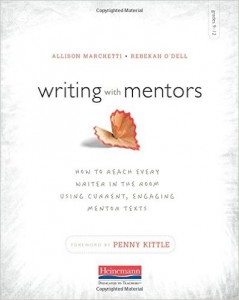 That’s why it’s so exciting to see the recent publication of
That’s why it’s so exciting to see the recent publication of  Megan Kortlandt (
Megan Kortlandt (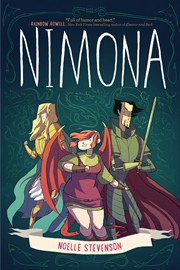
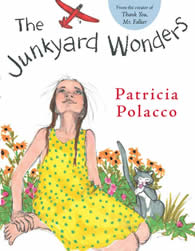 A few months ago, after soliciting ideas on social media, I selected
A few months ago, after soliciting ideas on social media, I selected 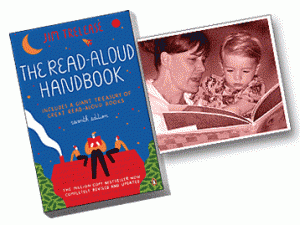 The ability to develop a passionate reading life is crucial, according to Jim Trelease, author of the best-selling
The ability to develop a passionate reading life is crucial, according to Jim Trelease, author of the best-selling 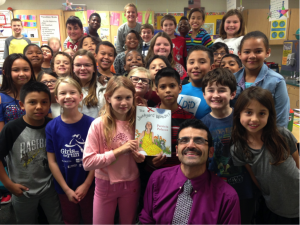
 Rick Joseph is a National Board Certified Teacher and has taught 5/6 grade at Covington School in the Birmingham Public School district since 2003. Prior, he served as a bilingual educator and trainer for nine years in the Chicago Public Schools. Rick is thrilled to serve as the 2016 Michigan Teacher of the Year. Through Superhero Training Academy, Rick’s students have created a superhero identity to uplift the communities where they learn and live.
Rick Joseph is a National Board Certified Teacher and has taught 5/6 grade at Covington School in the Birmingham Public School district since 2003. Prior, he served as a bilingual educator and trainer for nine years in the Chicago Public Schools. Rick is thrilled to serve as the 2016 Michigan Teacher of the Year. Through Superhero Training Academy, Rick’s students have created a superhero identity to uplift the communities where they learn and live.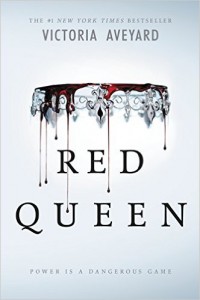
 As 2015 came to a close and winter break was upon us, I had some time to reflect upon my teaching practice, as I planned for my next units of study. I remembered how, at the beginning of the year, we received from our Literacy Specialist an immersion packet. The packet suggested several teacher-written pieces, which would go along with the units from Atlas.
As 2015 came to a close and winter break was upon us, I had some time to reflect upon my teaching practice, as I planned for my next units of study. I remembered how, at the beginning of the year, we received from our Literacy Specialist an immersion packet. The packet suggested several teacher-written pieces, which would go along with the units from Atlas. After I submit my pieces, our editor does his thing, which means inevitable changes to sentence structure, word choice, and sometimes even titles. I have to admit, it can be hard to take at times. This made me realize that I need to be more gentle in my approach with my students; more conversation needs to happen as I go through their pieces. It also made me realize how shared writing, revising and editing can help my students achieve better results.
After I submit my pieces, our editor does his thing, which means inevitable changes to sentence structure, word choice, and sometimes even titles. I have to admit, it can be hard to take at times. This made me realize that I need to be more gentle in my approach with my students; more conversation needs to happen as I go through their pieces. It also made me realize how shared writing, revising and editing can help my students achieve better results. Beth Rogers is a fifth grade teacher for
Beth Rogers is a fifth grade teacher for